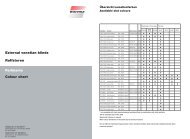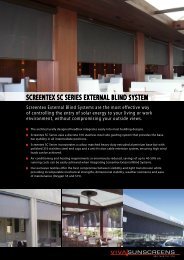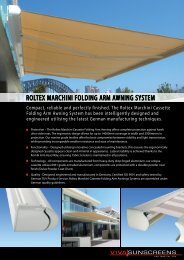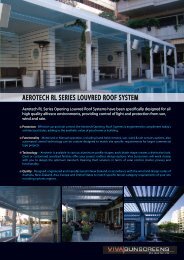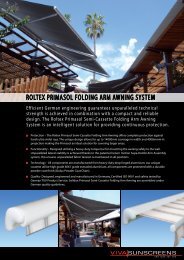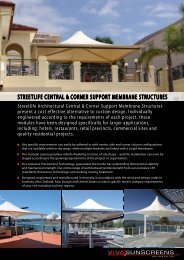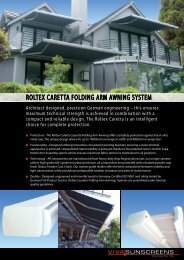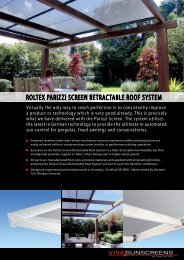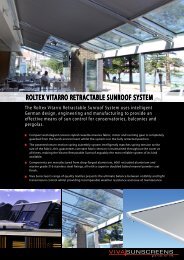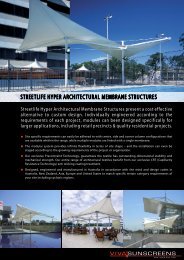Palazzo Assembly Instructions & User Manual - Viva Sunscreens
Palazzo Assembly Instructions & User Manual - Viva Sunscreens
Palazzo Assembly Instructions & User Manual - Viva Sunscreens
Create successful ePaper yourself
Turn your PDF publications into a flip-book with our unique Google optimized e-Paper software.
<strong>Palazzo</strong> Retractable Sunroof System<br />
Single - Flat system<br />
- <strong>Assembly</strong> and electrical installation instructions<br />
- <strong>User</strong> <strong>Manual</strong> advice<br />
Contents<br />
1. Before Arrival at the <strong>Assembly</strong> Site<br />
2. Tools Needed for <strong>Assembly</strong><br />
3. Fastening Equipment<br />
4. Noise Insulation<br />
5. Winter-use<br />
6. Electrical Installation<br />
7. Preparation of the <strong>Assembly</strong> Mounts<br />
8. Positioning and Fastening the <strong>Assembly</strong> Mounts to the Greenhouse<br />
9. Preparation of the Guide Rails<br />
10. Mounting the Guide Rails<br />
11. Preparation of the Awning Housing<br />
12. Mounting the Awning Housing<br />
13. Mounting the Base Support (Option)<br />
14. Mounting the Guide Rollers (Option)<br />
15. Mounting the Drive Belts<br />
16. Alignment of the Awning<br />
17. Test-run<br />
18. Setting the Stop-postions of the Motor<br />
19. Roof and Tin Cover Sheet<br />
20. Eletrical Hook-up – <strong>Instructions</strong> for the Electrician<br />
21. Operating <strong>Instructions</strong> for Tubular Motors<br />
22. Connection Errors<br />
22. Hazard Warning for the <strong>Assembly</strong>, Operation and Maintenance of an Awning<br />
24. What should I do when ……<br />
Stand 10/2005
Before Arrival at the <strong>Assembly</strong> Site<br />
Please read the assembly instructions. Make sure the awning and all accessories are present and undamaged.<br />
Check that the shipping is in accordance with your order.<br />
1. Tools Needed for <strong>Assembly</strong><br />
• Measuring-tape and pencil<br />
• Sturdy ladder<br />
• Size 2, cross-head screwdriver<br />
• Ratchet with extension and sockets size 8 and 10<br />
• Allen keys size 2.5, 4, 5 and 6<br />
• Motor – Test cable<br />
• 2 sawhorse trestles<br />
Tip:<br />
To ensure a safe and comfortable<br />
work-position on the greenhouse,<br />
lay a short, sturdy plank<br />
covered with carpeting on all<br />
sides on both the left and right<br />
sides of the outer covering strip.<br />
2. Fastening Equipment<br />
No fastening equipment is provided by the manufacturers for mounting the guide rails onto the roof of the<br />
greenhouse. The choice of the necessary fastening equipment depends on the chosen assembly mounts<br />
and the mounting conditions on site. If you are unsure about the choice of fastening equipment, consult a<br />
professional in fastening technique such as, for example, the Würth Firm.<br />
3. Noise Insulation<br />
The sound intensity level of this awning is approx. 68 dB (A) according to EN 292-2/A1. If noise insulation<br />
measures are necessary because of on-site circumstances, they should be implemented during the assembly<br />
process and based on the consultation of a professional. When in doubt consult a firm or assessor<br />
specialized in noise insulation techniques.<br />
4. Winter-use<br />
The awning may be damaged or destroyed under freezing conditions as a result of ice build-up on the rails<br />
as well as through the pile-up of snow or ice on the awning-canvas. If the awning-canvas is rolled up while<br />
wet it may also freeze together.<br />
The awning should only be operated after assuring that the guide rails are free of ice and snow and that<br />
the awning-canvas is dry. Automatic operation, when present, must be switched over to hand operation<br />
when there is a danger of frost.<br />
5. Electrical Installation<br />
Please ensure that the electrician receives the following “<strong>Instructions</strong> for the Electrician” (see Point 20.).<br />
To be sure, ask that the handing-over of the instructions be confirmed in writing.<br />
6. Preparation of the <strong>Assembly</strong> Mounts<br />
Various types of assembly mounts or distancing pieces are included depending<br />
on what you have ordered.<br />
Standard assembly mount or standard distancing piece<br />
(see Figure 1):<br />
2<br />
Loosen the setscrew (1) with a size 4 allen key and pull the clamp cylinder (2)<br />
out of the mount (3).<br />
3<br />
1<br />
Figure 1<br />
Stand 10/2005
<strong>Assembly</strong> mounts with side adjustment or adjustable distancing<br />
piece (see Figure 2):<br />
3<br />
Using a size 6 allen key, screw the cylinder screw (1) through the assembly<br />
mount top piece (2) into the square nut (3). Set all the adjustable distancing<br />
pieces to the desired height. Make sure that the telescopic tubes remain<br />
inserted with at least 20 mm of overlap. The height at which the pieces are<br />
set can vary, but the guide rails along the awning track mustn’t have any<br />
height offset with respect to one another.<br />
2<br />
1<br />
Figure 2<br />
7. Positioning and Fastening the <strong>Assembly</strong> Mounts to the<br />
Awning<br />
350 - 800<br />
max. 2000 max. 2000 max. 2000 max. 1500<br />
Figure 3<br />
Fasten the mounts to the greenhouse taking into consideration the pertinent handling instructions for use<br />
of the correct fastening equipment. In the process, ensure that the minimum and maximum measurements,<br />
as seen in Figure 3, are respected. The inside micrometer between the left and the right assembly<br />
mount is the same as the ordered-measurement of the awning (see shipping note). Differences in these<br />
measurements can only be corrected up to 20 mm in assembly mounts with side adjustment. Tighten the<br />
screws only to the point where they still allow the distancing piece to be adjusted in the slots.<br />
If the degree of adjustment isn’t sufficient, the awning is either too wide or too narrow and must be<br />
adjusted in the factory by the manufacturer.<br />
Never attempt to shorten the awning yourself; this will, in all cases, nullify the<br />
garantee.<br />
8. Preparation of the Guide Rails<br />
Figure 4<br />
Lay the guide rails on two sawhorse trestles, which you have prepared<br />
beforehand. Slide the clamping cylinder (1) as well as the<br />
assembly mount top piece (2), and the guide roller holder (3),<br />
which may be included, into the lower chamber of the guide rail.<br />
Take care to do this in the correct order. If a guide roller is included<br />
in the unit, fasten the guide roller holder in the middle of the<br />
guide rails. If several guide rollers are needed, space the holders<br />
evenly over the length of the guide rails.<br />
2<br />
1<br />
3<br />
Loosen the covering tin on the side of the exit baffle with a 2.5 mm<br />
allen key (see Figure 5).<br />
9. Mounting the Guide Rails<br />
Figure 5<br />
Fasten the guide rails to the assembly mounts (see Figures 6 and 7).<br />
Stand 10/2005<br />
Figure 6 Figure 7
Tighten up only the uppermost mount; leave the lower mounts loose. In the process, leave the top end<br />
sticking out approx. 100 mm over the middle of the uppermost mount.<br />
10. Preparation of the Awning Housing<br />
Lay the awning housing on top of two sawhorse trestles which<br />
you have set up beforehand. With a size 2 cross-head<br />
screwdriver, loosen the fastening screws (1) on the top (2) and<br />
lift it up (see Figure 8). With a 5 mm allen key, loosen the<br />
counter-sunk screws (3) and rosettes (4) for mounting the rails.<br />
Figure 8<br />
1<br />
2<br />
1<br />
3 4<br />
11. Mounting the Awning Housing<br />
Lift the awning housing up onto the greenhouse and place it<br />
above the ends of the guide rails (see Figure 9). Then lift the<br />
awning housing up to the height of the guide rails and insert<br />
the studs (1) in the guide rails (2). Screw the housing and<br />
the guide rails together with the counter-sunk screws (3) and<br />
rosettes (4), which you loosened before.<br />
1<br />
3 4<br />
2<br />
Figure 9<br />
Loosen the clamping screw on the uppermost assembly mount<br />
(1) on both sides and move the housing with the guide rails into<br />
its final position at the top (see Figure 10). Re-tighten the clamping<br />
screw on the uppermost assembly mounts (1); the rest of the<br />
mounts should remain loose.<br />
1<br />
Figure 10<br />
12. Mounting the Base Support (Option)<br />
For awning-widths over 5.50 m a base support, which<br />
corresponds to the height of the mounts, is included.<br />
This should be fastened in the middle part of the housing<br />
so that it rests on one of the covering strips of the<br />
greenhouse (see Figure 11). The fastening plates for<br />
the supports are to be found in the bottom groove of the<br />
housing base.<br />
1<br />
Figure 11<br />
13. Mounting the Guide Rollers (Option)<br />
Place the guide rollers, which are included, in the preassembled<br />
holders and screw them on with the help of a 6<br />
mm socket wrench (see Figure 12). The rollers have been<br />
cut to the exact length. Make sure that the guide rails do<br />
not become bent as a result of the rollers. To adjust for<br />
Stand 10/2005
this, use the available range of side adjustment in the slots of the assembly mounts. If the adjustment<br />
range is insufficient then the awning which you have ordered is either too wide or too narrow and must be<br />
changed in the factory by the awning manufacturer.<br />
14. Mounting the Drive Belts<br />
Figure 12<br />
The drive belts are wound in the factory in 5 coils on<br />
the belt spools. The drive belts are shipped as loose<br />
spools together with the rest of the parts. Open the<br />
spools and, following Figure 13, run the drive belts<br />
3<br />
2<br />
• over the pulleys in the awning housing (1)<br />
• through the bottom slot of the guide rails<br />
• around the front pulleys (2)<br />
• and back through the upper slot in the guide rails<br />
• finally, hang them onto the hooks in the carriage (3).<br />
1<br />
Figure 13<br />
When hanging the belts on the hooks in the carriage it is necessary that the belts are tightened<br />
(pulled) approx. 60 cm.<br />
Warning! Do not twist the drive belts.<br />
15. Alignment of the Awning<br />
It is very important that the guide rails are fixed at<br />
right angles to the awning housing. Check for this<br />
the following way (see Figure 14):<br />
• all A- measurements must be equal<br />
• both B- measurements (diagonals) must be<br />
equal<br />
• make sure that the guide rails are straight and<br />
run parallel to one another<br />
tighten up all the fastening screws on the assembly<br />
mounts<br />
90°<br />
B1<br />
A1<br />
A2<br />
B2<br />
A3<br />
Figure 14<br />
16. Test-run<br />
Stand 10/2005
The stop positions of the motor are not set. When running the awning out, make sure that the fasteners<br />
for the drive belt loops do not clash with the pulleys on the guide rails! (see indicator note)<br />
a) Run the awning out and check:<br />
• Are the drive belts running smoothly through the front pulleys<br />
If not: Check the awning alignment. (Point 16)<br />
• Does the awning-canvas lie free of diagonal folds<br />
If not: Check the awning alignment. (Point 16)<br />
• Do the drive belts run smoothly on the belt spools<br />
If not: Check the awning alignment. (Point 16)<br />
b) Run the awning in and check:<br />
• Does diagonal folding occur<br />
If so: Check the awning alignment. (Point 16)<br />
• Observe whether the built-in free-wheel limit switch in the motor cable switches off.<br />
If not: See Point 19<br />
TIP :<br />
The motor is equipped with an overheating-guard. You can only run the awning<br />
out and in 2 – 3 times. After that, the motor will shut off.<br />
After about 30 minutes it cools off and is ready to be operated again.<br />
17. Setting the Stop-positions of the Motor<br />
The stop-positions of the motor must be set during assembly.<br />
Proceed as follows:<br />
When the awning cover or the revisions cover is open, the set-up buttons are visible. The button furthest forward<br />
in the direction of the awning when running it out is the button for the stop-position of the awning when<br />
running it out. The button furthest back is for the stop-position when withdrawing the awning.<br />
Both buttons are engaged by pushing them in.<br />
Outward direction:<br />
The end shaft is run out until the indicator markings on the guide rails and then stopped. By pushing the<br />
forward button again, the stopping-point is remembered by the motor and the button springs out a little.<br />
The stopping-position is now set.<br />
Warning! Never let the end shaft run past the indicator markings! The awningcanvas<br />
will stretch after being used for a while. If the stop-position is set incorrectly,<br />
the belt fasteners could run into the pulleys and thereby damage the entire<br />
awning.<br />
Stand 10/2005
Inward Direction:<br />
When running the awning in, the shut-off occurs through an external end-switch. This happens when the<br />
inward stop-position is reached by way of the roll-course of a carriage. In order that the stop-position is<br />
properly reached, the back set-up button must always remain pushed (engaged).<br />
18. Cover and Tin Cover Sheet<br />
a) Lay the awning-cover on top, so that the grooves on the backside tie into one another. Finally, screw<br />
in the cover fastening screws again.<br />
b) Screw the tin cover sheet into the exit baffles.<br />
19. Electrical Hook-up – <strong>Instructions</strong> for the Electrician<br />
Warning!<br />
Awnings are not portable devices and must be operated by means of a fixed electrical connection.<br />
Electrical installation work on a 230 V power supply may only be carried out by accredited specialists!<br />
When installing the electrical connection, the applicable VDE-Guidelines and the regulations of the<br />
energy company in your area must be followed. During installation, the possibility of an all-pole<br />
separation from the power supply must be created using, for example, a Hirschmann connector, a<br />
dipolar sunblind switch with a minimum of a 3 mm contact opening, or an all-pole main switch. The<br />
‘in’ and ‘out’ commands must exclude each other. During change in the direction of rotation, the<br />
drive must be idle for at least 0.5 sec.<br />
When these instructions are not followed, when the electrical connection is not carried out properly according<br />
to DIN, or when the recognized technical rules are ignored, neither the motor nor awning manufacturers<br />
are responsible for material damage or personal injury (see Figure 15):<br />
• Never connect more than one motor to a single-pole switch!<br />
• Only by using group control can more than one motor be operated by a single<br />
switch.<br />
• Switches for the awning motors must be electrically and mechanically controlled.<br />
• Lay the motor cables such that water drops do not run down the cable into the<br />
motor (droplet kink).<br />
Stand 10/2005
Figure 15<br />
21. Operating <strong>Instructions</strong> for Tubular Motors<br />
Warning!<br />
NOT all plug-in motors are necessarily the same as other common household<br />
electrical devices! It is essential that you pay careful attention to the following<br />
operating instructions.<br />
a) Never activate motors in parallel.<br />
b) Never run motors with the ‘in’ and ‘out’ switches activated at the same time.<br />
c) Ensure a switch pause between ‘in’ and ‘out’ commands of approx. 0.5 seconds.<br />
22. Connection Errors<br />
The most common causes for the overloading of limit switches are explained below in order to prevent defects<br />
in the micro-switches.<br />
a. Parallel connection of two or more drives<br />
Drives connected in parallel never have exactly the same running time. Therefore, the drive that is<br />
shut off first receives an inductive and capacitative tension in the opposite direction from the drive that<br />
is still running. This reverse tension, which can be up to 1,000 volts, sets the shut off drive in motion in<br />
the opposite direction until it receives system tension again from the limit switch and begins to run<br />
again in the opposite direction. This pendulum motion continues until all parallel-connected drives<br />
reach their stop positions. Each time the drives are shut off in this fashion the limit switch is overloaded<br />
and damaged (see also Point ‘c’, ‘Switch-pause too short’). Furthermore, this often results,<br />
Stand 10/2005
apart from the pendulum motion, in an altered stop position for the awning. In extreme cases, the limit<br />
switches become permanently fused which causes the continuous activation of the motor.<br />
b. Simultaneous ‘in’ and ‘out’ signals<br />
Through the use of switches which aren’t mutually exclusive or the installation of various non-exclusive<br />
switch positions, the simultaneous activation of the ‘in’ and ‘out’ directions can occur. This is not allowable<br />
since the limit switch contacts will be overloaded as a result of reverse induction that occurs in the<br />
motor coils. The resulting damage is similar to that described in Point ‘a’.<br />
c. Switch-pause too short<br />
In some installations it was determined that the switch pause between ‘in’ and ‘out’ signals was not<br />
sufficient. The control must have a switch pause of approx. 0.5 seconds when switching running<br />
directions. This is needed to ensure that the mechanical drive comes to a complete stop and that the<br />
induction tension in the motor and the charge in the capacitor wear off. If a drive is switched over too<br />
quickly, extremely high currents result briefly which damage the contacts of the controlling relays –<br />
and sometimes only momentarily – they fuse. This leads to the simultaneous activation of both<br />
operating directions. As a result, the micro-switches in the drive become damaged (see Point ‘b’).<br />
Failures of this type occur often especially in programmable units (SPS, EIB) or in self-designed relay<br />
switches.<br />
All of the problems caused by the effects described above usually occur after a certain operating time<br />
since the limit switches can only withstand the strain a few times. All these effects are taken into consideration<br />
in the controls or switches that come with the unit.<br />
23. Hazard Warning for the <strong>Assembly</strong>, Operation and Maintenance of an Awning<br />
Awnings set-up outside are subjected to strong external forces resulting from weather influences<br />
(eg. wind factors, weight-loads from rain and snow).<br />
Follow the assembly instructions carefully during assembly. It is advisable to allow a specialist<br />
to carry out the assembly.<br />
• Make sure of the stability and design of the surface on which you are assembling. It must be<br />
able to accept the forces imposed upon it by the operation of the awning.<br />
• Electrical connections may only be installed by an authorised electrical specialist and taking<br />
into consideration the applicable VDE-guidelines and the regulations of the on-site energy supply firm.<br />
• Awnings operated by electrical motors with mounting heights of less than 2.5 m must be<br />
controlled by way of a non-locking button in plain view. The possibility of someone reaching into<br />
moving parts must be excluded during operation.<br />
Warning!<br />
There is a danger of injuries resulting from crushing or clamping!<br />
• With wind-forces above 5 (8 to 11 m/s wind speed - large branches move) the awning<br />
must be withdrawn! Damage to the awning could occur.<br />
• Awnings are not rain-protection devices. Operation during light drizzles is, however, possible.<br />
The canvas must have a slope of at least 15°. The water must run off, a water skin build-up is not<br />
allowable (damage through high water weights is possible).<br />
An awning-canvas that has been rolled up wet must be rolled out and allowed to dry as soon as<br />
possible (mould build-up, water stains).<br />
Stand 10/2005
• Awnings must not be operated in snowy or icy conditions. A frozen canvas can damage<br />
the awning! Therefore, when there is danger of ice or snow, use the manual control rather than<br />
the automatic awning control for your safety!<br />
• For maintenance or cleaning and repair jobs (service), the electrical drive must be disconnected<br />
from the power supply (eg. safety, Hirschmann connector, or main switch).<br />
Warning!<br />
Even awnings that have been run out manually can be automatically<br />
switched on by means of a wind-watcher (wind activated sensor). Therefore to prevent accidents always<br />
ensure disconnection from the power supply.<br />
• No long objects should be placed in the area covered by the awning since an activated awning could<br />
collide with them and cause them to fall over.<br />
Warning!<br />
There is a danger of injury from falling objects.<br />
24. What should I do when……<br />
…… the end shaft runs up crooked under<br />
the awning cover<br />
Figure 16<br />
As portrayed in Figure 16, the end shaft runs too<br />
far under the awning cover on the right side. The<br />
cause of this is an overly loose belt tension on the<br />
right side.<br />
Solution: increase the belt tension on the right<br />
side. Unhook the drive belt and set the belt-length<br />
100 mm shorter on the belt fastener.<br />
…… a diagonal fold is produced on<br />
one side while running the awning<br />
in<br />
Figure 17<br />
Make sure the awning is properly aligned as<br />
described in Point 16.<br />
If this fold is produced despite the proper<br />
alignment of the awning, as displayed in<br />
Figure 17, it may be a result of the canvas<br />
tension. Awning canvasses are cloths sewn<br />
from webbing in which, either as a result of<br />
the webbing itself or of the sewing, an uneven<br />
tension can result.<br />
Solution: Change the alignment of the awning to suit the canvas. Loosen the clamping screws of the opposite<br />
guide rail, on the right in the diagram, and pull the rail a few mm down. Observe that the fold<br />
disappears or becomes noticeably smaller.<br />
Note: It can occur (especially in large SOLTIS –canvasses), that small diagonal folds are produced on<br />
both sides. These are unavoidable and can only be reduced by building in additional guide rollers.<br />
Stand 10/2005
…… the motor keeps on running even when the<br />
end shaft has been totally withdrawn under the<br />
awning cover<br />
Figure 18<br />
The little limit stop lever of the external limit switch has<br />
been bent or has fallen off.<br />
Solution. Open the awning cover. Check the external limit<br />
switch screwed into the side cap. The back roller of the<br />
carriage must make contact with the limit switch lever and<br />
switch it off.<br />
…… despite a functioning electrical connection,<br />
the end shaft doesn’t move<br />
It is possible that the little limit stop lever of the external limit switch has seized or has been bent and as a<br />
result is stuck in the engaged position.<br />
Solution. Open the awning cover. Check the external limit switch screwed into the side cap.<br />
Stand 10/2005



